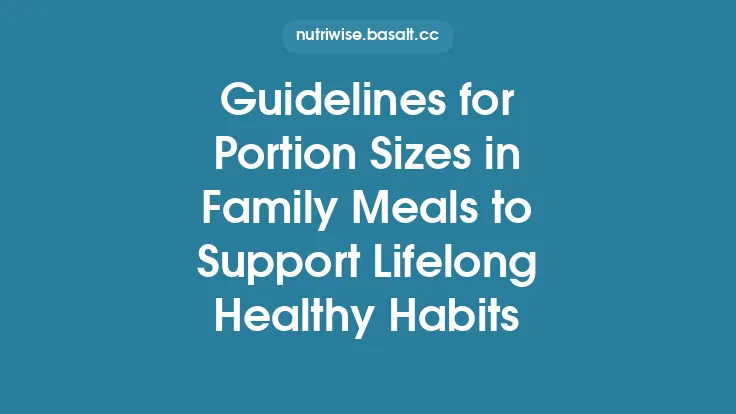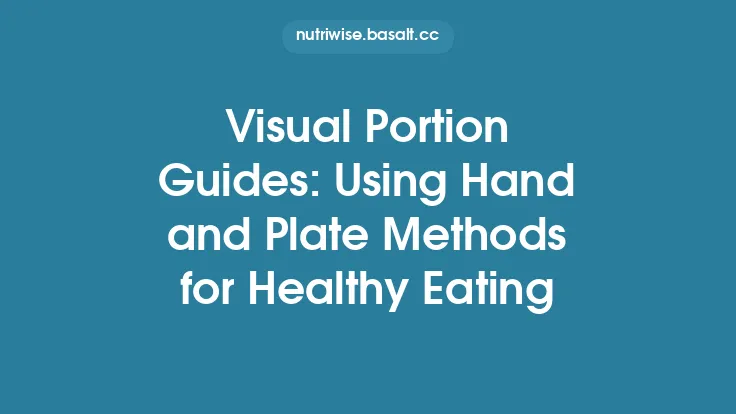A balanced approach to dietary fat is essential for overall health, yet many people struggle to translate abstract recommendations into everyday food choices. This article breaks down the current scientific guidance on how much fat you should aim for each day, how to express those amounts in practical portion sizes, and how to adjust the numbers to fit your personal goals, activity level, and life stage. By the end, you’ll have a clear roadmap for planning meals that meet the recommended fat range without over‑ or under‑consumption.
Understanding the Recommended Fat Percentage
Why a percentage, not a fixed gram amount?
Total energy needs vary widely—from a sedentary adult consuming 1,800 kcal per day to an endurance athlete burning 3,500 kcal. Expressing fat intake as a percentage of total calories automatically scales the recommendation to match individual energy requirements.
| Population group | Typical daily kcal range | Recommended fat % of total kcal* |
|---|---|---|
| General adult (sedentary) | 1,800–2,200 | 20–35 % |
| Moderately active adult | 2,200–2,800 | 20–35 % |
| Highly active adult/athlete | 2,800–3,500+ | 20–35 % |
| Older adults (≥65 y) | 1,600–2,200 | 20–35 % |
| Pregnant/lactating (2nd‑3rd trimester) | 2,200–2,900 | 20–35 % |
\*These ranges are drawn from the Dietary Guidelines for Americans (2020‑2025) and the Institute of Medicine’s Acceptable Macronutrient Distribution Ranges (AMDR).
Upper and lower bounds:
- Lower bound (≈20 %): Guarantees enough essential fatty acids and supports absorption of fat‑soluble vitamins (A, D, E, K).
- Upper bound (≈35 %): Helps prevent excess caloric intake from fat, which is the most energy‑dense macronutrient (9 kcal/g vs. 4 kcal/g for carbs and protein).
Translating Percentages into Grams
Because fat provides 9 kcal per gram, you can convert the percentage range into a gram range with a simple formula:
\[
\text{Fat (g)} = \frac{\text{Total kcal} \times \text{Fat \%}}{9}
\]
Example calculations
| Daily kcal | 20 % fat (g) | 30 % fat (g) | 35 % fat (g) |
|---|---|---|---|
| 1,800 | 40 g | 60 g | 70 g |
| 2,200 | 49 g | 73 g | 86 g |
| 2,800 | 62 g | 93 g | 109 g |
| 3,500 | 78 g | 117 g | 136 g |
These gram targets become the baseline for planning portion sizes throughout the day.
Portion‑Size Guides for Common Fat‑Containing Foods
Below are “real‑world” equivalents that approximate the gram amounts listed above. All values are averages; actual fat content can vary slightly by brand or ripeness.
| Food item | Typical serving size | Approx. fat (g) |
|---|---|---|
| Olive oil (or any liquid oil) | 1 Tbsp (15 mL) | 14 g |
| Butter or margarine | 1 tsp (5 g) | 4 g |
| Avocado (medium) | ½ fruit (≈100 g) | 15 g |
| Almonds (raw) | ¼ cup (≈30 g) | 14 g |
| Peanut butter | 2 Tbsp (32 g) | 16 g |
| Cheddar cheese | 1 oz (28 g) | 9 g |
| Whole‑milk yogurt (plain) | 1 cup (245 g) | 8 g |
| Salmon (cooked) | 3 oz (85 g) | 7 g |
| Egg (large) | 1 whole egg | 5 g |
| Dark chocolate (≥70 % cacao) | 1 oz (28 g) | 12 g |
Practical tip: Use the “hand method” to estimate portions without a scale:
- Palm ≈ 3 oz of protein or 1 Tbsp oil (≈14 g fat)
- Fist ≈ 1 cup of cooked vegetables or fruit (minimal fat)
- Thumb ≈ 1 tsp butter or nut butter (≈4–5 g fat)
Building a Daily Fat Plan
- Set your calorie target.
Use a reputable calculator (e.g., Mifflin‑St Jeor equation) that accounts for age, sex, weight, height, and activity level.
- Choose a target fat percentage.
For most adults, 30 % is a comfortable middle ground. Adjust upward if you follow a higher‑fat diet (e.g., ketogenic) or downward if you’re aiming for weight loss while keeping protein adequate.
- Calculate gram target.
Apply the formula above. Example: 2,400 kcal × 30 % ÷ 9 = 80 g fat per day.
- Distribute across meals.
A common split: 25 % of daily fat at breakfast, 30 % at lunch, 30 % at dinner, and 15 % in snacks. For the 80 g example:
- Breakfast: 20 g (≈1 Tbsp oil + ½ avocado)
- Lunch: 24 g (≈2 Tbsp olive oil in dressing + ¼ cup nuts)
- Dinner: 24 g (≈3 oz salmon + 1 tsp butter)
- Snacks: 12 g (≈1 oz dark chocolate)
- Track with a simple log.
Use a notebook, spreadsheet, or a free nutrition app. Record the food, portion, and fat grams. Review weekly to see if you consistently hit the target range.
Adjusting for Special Situations
| Situation | Recommended adjustment | Rationale |
|---|---|---|
| Weight loss (moderate deficit) | Keep fat at 20–30 % of reduced calories | Fat remains satiating; protein should be prioritized to preserve lean mass. |
| Weight gain / muscle building | Maintain 25–35 % of higher calories; consider slightly higher fat if appetite is low | Extra calories from fat are easier to consume for some athletes. |
| Older adults (≥65 y) | Aim for the upper end (30–35 %) | Helps meet higher needs for energy and supports absorption of fat‑soluble nutrients. |
| Pregnancy & lactation (2nd/3rd trimester) | 25–35 % of increased calories; ensure adequate DHA through fortified foods or supplements (outside scope of this article) | Supports fetal development and milk production. |
| Metabolic conditions (e.g., type 2 diabetes) | 20–30 % with emphasis on unsaturated sources (but not a deep dive into types) | Helps control overall caloric intake while providing satiety. |
| Very high‑intensity endurance training | 30–35 % of total calories; consider timing fat intake around training sessions to avoid gastrointestinal discomfort | Fat is a secondary fuel; higher intake can aid total energy balance. |
Tools and Resources for Accurate Portion Control
| Tool | How it helps | Practical tip |
|---|---|---|
| Digital kitchen scale | Provides gram‑level accuracy for high‑fat foods (nuts, oils, cheese) | Weigh a tablespoon of oil once; then you can eyeball the same amount later. |
| Measuring spoons & cups | Quick reference for liquids and spreads | Keep a set of 1‑tsp, 1‑Tbsp, and ¼‑cup measures in the pantry. |
| Food‑label database (USDA FoodData Central) | Gives precise fat grams per standard serving | Search “almonds” → 1 oz = 14 g fat; use that as your reference. |
| Hand‑size visual guide | No equipment needed; useful when eating out | Remember: a thumb ≈ 5 g fat, a palm ≈ 14 g fat. |
| Smartphone nutrition apps | Log meals on the go; many have barcode scanners | Review daily totals each evening to stay within range. |
Common Questions (FAQ)
Q: Do I need to count saturated fat separately?
A: While the primary focus here is total fat, most health agencies advise keeping saturated fat below 10 % of total calories. In practice, this often translates to ≤ 20 g per day for a 2,000‑kcal diet. You can achieve this by favoring whole‑food sources (e.g., nuts, seeds, fish) and limiting large portions of butter or fatty cuts of meat.
Q: What if I’m following a low‑carb diet that recommends 60 % of calories from fat?
A: That approach falls outside the standard AMDR and is considered a therapeutic diet (e.g., ketogenic). If you choose this path, it’s advisable to do so under professional supervision to monitor lipid profiles and nutrient adequacy.
Q: How do I handle restaurant meals where portion sizes are unknown?
A: Use the hand‑size method as a quick estimate, or ask the server for a “half‑portion” of high‑fat items (e.g., sauces, cheese). When possible, request dressings and sauces on the side so you can control the amount added.
Q: Is it okay to get all my fat from one food source?
A: Variety is key for micronutrient diversity. While the article does not delve into specific fatty‑acid types, consuming a range of whole‑food fats (nuts, seeds, fish, dairy, plant oils) helps ensure you obtain a balanced nutrient profile.
Putting It All Together: A Sample Day (2,400 kcal, 30 % Fat)
| Meal | Food & Portion | Approx. Fat (g) |
|---|---|---|
| Breakfast | 2 eggs scrambled with 1 tsp butter, ½ avocado, 1 slice whole‑grain toast | 20 |
| Mid‑morning snack | ¼ cup almonds | 14 |
| Lunch | Mixed greens with 3 Tbsp olive‑oil vinaigrette, 3 oz grilled chicken, ½ cup quinoa | 24 |
| Afternoon snack | 1 oz dark chocolate + 1 tsp peanut butter | 12 |
| Dinner | 4 oz baked salmon, 1 tsp butter on steamed broccoli, ½ cup brown rice | 24 |
| Total | — | 94 g (≈31 % of 2,400 kcal) |
This example demonstrates how the recommended fat range can be met using everyday foods and simple portion cues.
Final Takeaway
Healthy fat intake is best viewed as a flexible band rather than a rigid number. By anchoring your plan to a percentage of total calories, converting that to grams, and then using concrete portion‑size references, you can confidently meet the 20–35 % guideline in a way that fits your lifestyle, goals, and physiological needs. Regular monitoring, modest adjustments, and a focus on whole‑food sources will keep you on track for long‑term wellness without the need for exhaustive nutrient‑type deep dives.





